Optical telescopes. The temptation of grief
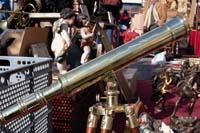
History reveals that the discovery took place at the factory of a Dutch eyewear manufacturer. While playing, one of the young collaborators participated in a convex and concave lens in each hand. Before reaching the young man's eye, the light passed through the convex lens and the concave respectively. The young man then saw distant objects as if they were closer.
It is true that this effect can be achieved with a single lens or convex lens. That is, with a magnifying glass we can see small details of the seals or study the morphology of an insect. And the magnifying glass is just a convex lens. But if the magnifying glass is far from paper, the letters, in addition to growing, deform. That is the function of the concave lens, to render without effect the deformation that has inevitably produced the convex lens by increasing the image.
This deformation of light as it passes through a lens is called refraction. That is, when moving from one medium to another, light changes direction of propagation. In this case the refraction is due to the different density of air and glass and the torsion of the glass lens.

Refractive telescopes
The refractive telescope is only a device that uses the refractive effect, that is, a tube with the convex lens and the concave at both ends. You look through the concave or ocular lens and place the end with the convex lens or lens opening towards the object you want to see enlarged.
The larger the diameter of the magnifier, the larger the seal. The same happens with the lens opening of the refractive telescope. The larger the diameter, the greater the telescope increase, which will allow you to see things further away. More distant things will be seen, but always to some extent. This is because the larger the diameter of the lens opening, the more expensive the refractive telescope is.
Reflection telescopes

When the light enters through the tube, it meets the main mirror. This mirror is concave and directs light to another smaller, flat mirror. The mission of this second mirror is to direct the light deformed by the main mirror towards the eyepiece.
The similarity between both types of telescopes is evident. Although one uses lenses and the other mirrors, convex or concave lenses and mirrors deform the light and increase the images.
Aberration and focal length
In reflection telescopes, light is reflected in mirrors and changes direction. No more. On the contrary, in refractive telescopes the light deforms through the window. This produces an effect called chromatic aberration. This effect can be described by this simple experiment.
The white light of a flashlight must be projected onto a glass prism. Once done, the white light breaks down into a kind of rainbow. The lens of the refractive telescope does the same. It breaks down white light into colored light and this effect is called chromatic aberration.
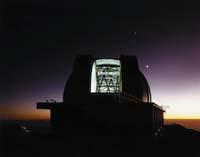
The distance from lens aperture to focus is called focal length. This concept is important because it directly affects the increase of the telescope. In short, the magnification is directly proportional to the focal length of the lens opening and inversely proportional to the focal length of the eyepiece.
However, to obtain the same diameter as lens aperture, reflection telescopes only have a shorter tube. This, of course, has economic advantages, as less material is needed to build the telescope. Of course, this advantage is significant when building a giant telescope building. As if that were not enough, the mirrors are cheaper than the lenses -- the same amount of material is not needed to make the surface or the volume -- and, as the light does not disperse depending on the wavelength, the mirror telescopes do not suffer chromatic aberrations.
The problem to explore the sky is the atmosphere

Chromatic aberration is not the only drawback we will suffer when using the telescope. In case you want to inspect stars or stars, fluctuations of atmospheric air
can distort the image. We must think that there are several kilometers of atmosphere on the earth's surface and that the atmospheric air moves at great speed.
There is only one solution to this problem. The higher the telescope is placed, the less atmosphere will be between the stars and the target and therefore less distortion. Hence most astronomical observatories are located in high mountains. For example, the viewpoint located in Cerro Paranal in Chile is at a height of 2,665 meters.
And if this is not enough, the telescope can be inserted into a spacecraft and sent into the atmosphere to pray the Earth. In this way, the problems that the atmosphere can cause have ended. The Hubble Reflection Telescope has been taking images of distant galaxies around the Earth for years. But there are few telescopes like Hubble, among other reasons because they are expensive and have maintenance and management problems.
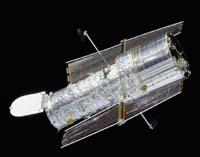
But without looking at the band of the electromagnetic spectrum, optical telescopes are still widely used for the study of stars and stars.
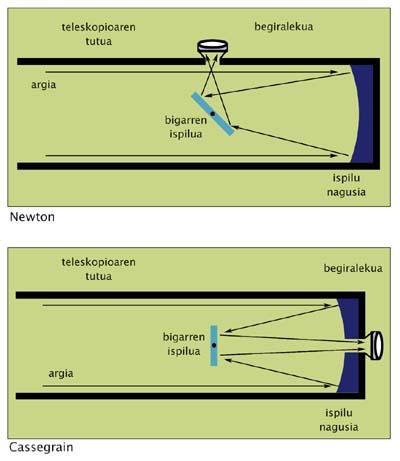
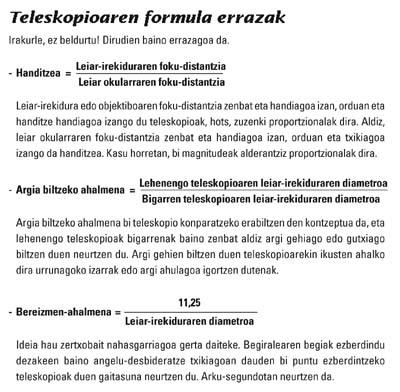
Buletina
Bidali zure helbide elektronikoa eta jaso asteroko buletina zure sarrera-ontzian











